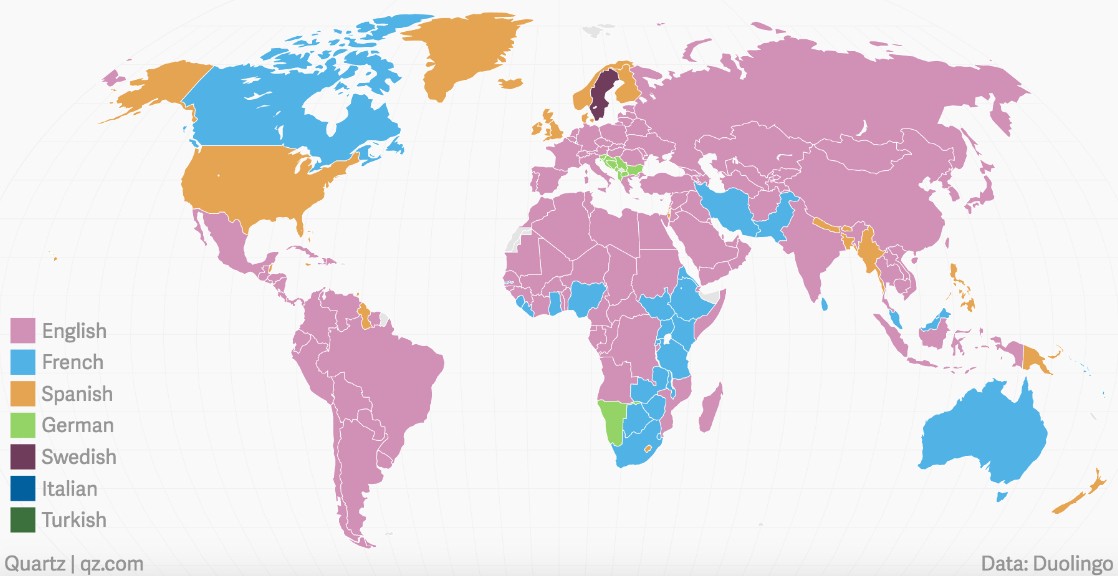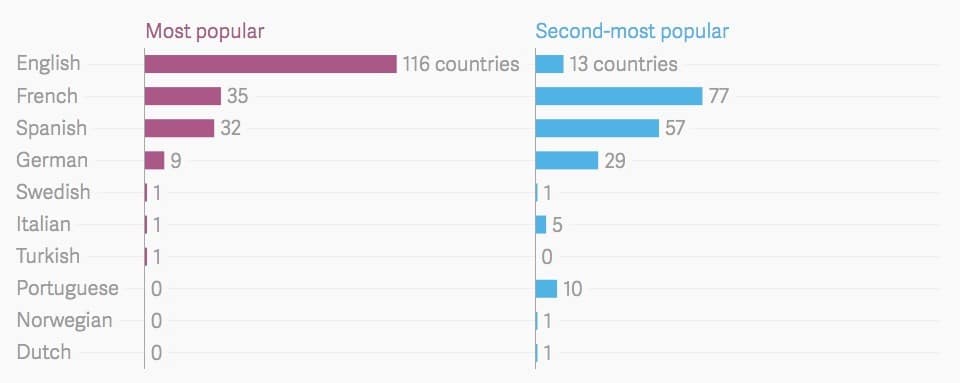At Atlas & Boots, we have mentioned Duolingo in nearly all our language posts, be it expert tips for learning multiple languages or tools for lazy learners. We are big fans of the app and were intrigued by its recent findings on the most popular languages being studied around the world.
The team mined data from every country in the world over the course of three months to identify the most popular languages being studied by its 120 million users. The results are fascinating.
Before we look at the most interesting findings, we should mention that Duolingo currently offers 19 languages, not all of which are translatable to every other language. As such, there is some natural bias in the data but it offers some interesting insights nonetheless.
English is the most popular language by far
Learning English is the first choice language in three times as many countries as the second most popular language. English is one of the top two most popular languages in two-thirds of all countries and, when aggregated across all countries, is being studied by 53% of all Duolingo users.
French is the second most popular language
French is second of the most popular languages from two perspectives.
- It is the second most popular first-choice language (35 countries compared with English’s 116)
- It is the most popular second-choice language (77 countries compared with Spanish’s 57)
This confirms our assertion that French is the best language to learn for those who already speak English. It should be said, however, that French is in close competition with Spanish. Although it is one of the top two most popular languages in 58% of all countries compared with Spanish’s 46%, only 11% of all Duolingo users are learning French compared with 17% learning Spanish.
Swedish is the most popular language of study in Sweden
This anomaly is certainly distinctive in the map above. After all, aren’t Scandinavians supposed to be excellent with languages?
Duolingo has an explanation for why 27% of all users in Sweden are learning Swedish: “Immigration to Sweden has been skyrocketing in recent years: one in six Swedish residents in 2015 was born outside of Sweden. The fastest growing foreign-born groups are from Syria and Afghanistan, reflecting a recent increase in the refugee population.”
English is the second most popular language of study in the US
English is second of the most popular languages being studied in the US (21% of all users). Similar to Sweden, this may be explained by immigration.
The immigrant share of the total US population is over 13% and over 25 million people say they speak English less than ‘Very Well’, which likely explains why so many are using Duolingo to learn English.
Some natives can’t speak their official languages
Separate to immigration, some natives can’t speak their official languages. In India, for example, English is an official language (along with Hindi) but only 10% of Indians speak it which explains why it’s the most popular language being studied.
As former Portuguese colonies, Angola and Mozambique maintain Portuguese as their sole official language. Despite this, a respective 40% and 50% of natives speak the language. As such, it is second of the most popular languages being studied after English, which in turn is a prerequisite for studying Portuguese.
In Canada, the most popular language of study is French. Duolingo ponders: “French is spoken mostly in the region of Québec… The other parts of Canada are much less bilingual, even though French is mandatory as a second language for most Canadian students. Is this requirement the reason why a third of Duolingo users in Canada are learning French? Or is it because most Canadians truly want to learn their other official language?”
Unlike its neighbours, Argentina is studying Italian
Italian is second of the most popular languages being studied in Argentina (after English). This is an anomaly of sorts since Italian appears in the top two nowhere else on the continent.
The reason becomes clear when you learn that 63% of Argentines have Italian blood due to great waves of immigration in the 19th and 20th centuries.
Unlike its neighbours, Guyana is not studying English
Unlike the rest of South America, Guyana is not studying English as one of its top two choices, instead opting for Spanish and Portuguese.
After over a century of British rule, it’s natural that Guyana has proficiency in English. In fact, it’s the country’s official language unlike any of its neighbours on the continent.
German is the most popular language of study in Namibia
For those unfamiliar with the history of colonisation in Namibia, it may be surprising that German is the most popular language being studied there.
In Namibia, German is the most popular language of study (Image: Public Domain)
In fact, it’s likely a result of German rule under which Namibia fell in 1884. German was one of of the country’s official languages until 1990 and is currently spoken by 32% of Namibia’s white population.
Bangladesh is not studying English
Spanish is the most popular language being studied in Bangladesh with French second. It seems strange that English is not more popular. Is this because of Bangladeshi leaders’ efforts to de-emphasise English post-independence? Could it be because of a relatively low-quality Bengali-English Duolingo course? Do Bengalis have an affinity with Spain we don’t yet know about?
Language learning trends can often reflect deeper societal and educational dynamics. For students navigating academic challenges, whether in language studies or other subjects, many seek out support, like those who hire paper writers for college to refine their work. If anyone has insights, we welcome facts or theories that can offer clarification!













